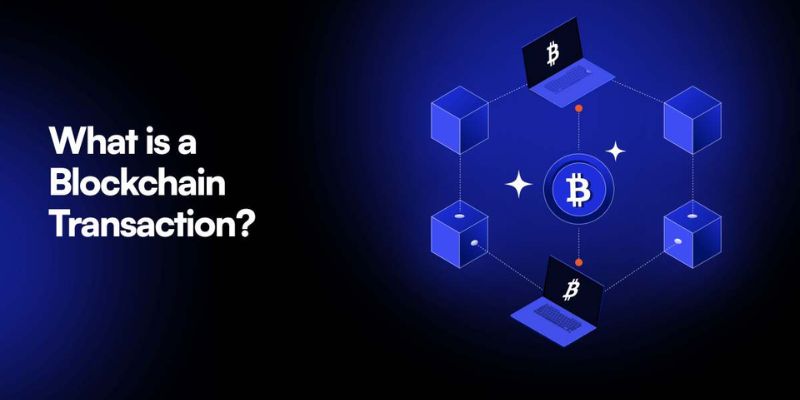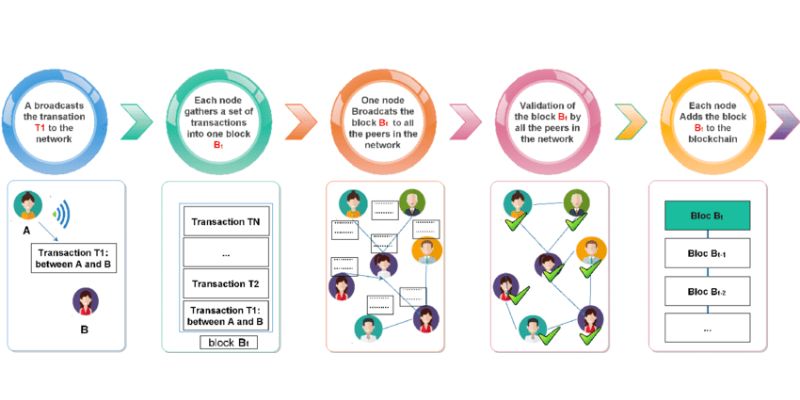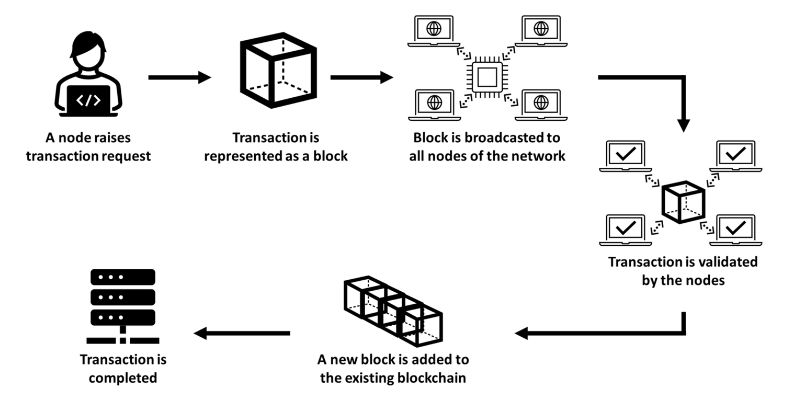Unpacking Blockchain Magic: What Exactly is a Transaction?
Imagine a magic ledger that never lies. Every “abracadabra” is a What is a transaction in blockchain? Here’s the no-snooze scoop: A blockchain transaction is a smart, secure swap recorded on that magic ledger. Think of it like sending a secret note that everyone can see, but only you can sign. It’s a digital handshake that says, “Yes, this is mine, and now it’s yours.” Want to get into the nitty-gritty? Dive with me into a world where each click sends cryptic codes flying, sealing deals with digital certainty.
The Anatomy of a Blockchain Transaction
Understanding Ledger Entries and Digital Wallet Interactions
Think of blockchain as a magic book. Every page tells a story of who sent money to whom. It’s not like a diary that hides under your bed, though. This magic book is open for everyone to see. Now, let’s talk about how money moves in this world.
In blockchain, we have things called digital wallets. These are like pockets full of digital coins, called cryptocurrencies. A digital wallet keeps your money safe. It has a secret key that only you know. To send money, you use this secret key to sign off on the deal.
When you send money, you make a ledger entry. This is like writing in that magic book, telling the world you paid someone. Ledger entries in blockchain say, “Hey, I gave this much money to that person!” They keep track of all the deals everyone makes. Like a hall monitor, but for money.
Deciphering Blockchain Transaction Process and Verification
So how do you know the magic book isn’t lying about who owns what? That’s where the rest of the magic comes in. When you send money, it starts a blockchain transaction process. It’s like telling the teachers – called mining vehicles – you want to move your money.
These mining vehicles are super-smart. They solve tough puzzles called hashes to prove you’re good for the money. These puzzles make sure everything adds up, so nobody’s cheating or copying money they don’t own, which is a big no-no.
After the puzzles are done, the deal – your transaction – goes into a block. A block is like a locker, where your deal hangs out with other deals waiting to be checked out. Once the block is full, it gets a special lock on it that keeps all the deals inside safe.
The final step is the blockchain transaction confirmation. This is like when the hall monitor gives you a thumbs up. It confirms that the deal really happened. If more blocks get added after yours, it’s like more locks on that locker, making it even stronger. Confirming transactions on blockchain takes some time, but it’s important because it keeps everyone honest.
One cool thing is that once a deal is done on the blockchain, it can’t be undone. This is called immutability. It’s like if you wrote in the magic book with super glue ink. That’s why we trust blockchain so much. It’s always on point, and the stories—er, I mean transactions—never change.
The Mechanics Behind Secure Blockchain Transactions
Cryptographic Signatures and Public/Private Key Infrastructure
When you send or get money through your digital wallet, a fancy math trick seals the deal. This trick is called a cryptographic signature. It proves you agreed to the transaction. Think of it like a secret code that only your wallet can make, but everyone can check to make sure it’s really yours.
Your wallet has two keys: a public one and a private one. The public one is like your home address; anyone can know it to send you money. But the private one? That’s only for you. It’s like the key to your house. You use it to sign off on cryptocurrency transactions. It’s super-secret and keeps your money safe.
Imagine you’re playing catch with a friend, but you’re using a boomerang. You toss it (that’s your public key) and it comes back to just you (your private key).
The Role of Hashing and Encryption in Ensuring Transaction Integrity
In the blockchain world, every deal you make gets scrambled up to protect it. That’s hashing for you. It turns your deal, or transaction, into a jumble of letters and numbers. And once it’s hashed, it can’t be changed back. If even one tiny part is different, the whole scramble turns out different.
This locking of data helps everyone trust the system. They know that what’s written in the ledger is what really happened. And it’s not just one lock; there’s a whole chain of them. Each block in the chain protects the one before it. That’s why it’s called blockchain.
Imagine you’re writing a secret note, and you lock it in a box. You then put that box in another bigger box, lock it, and so on. If someone tries to mess with the small box, they have to get through all the other boxes first. It’s a really good way to keep your secrets safe.
Encryption is another part of keeping your info safe in blockchain. It’s like writing a note in a secret code. Only the person with the right code can read it.
What does this mean for blockchain operations? They’re like super-safe postcards. Anyone can see them, but only you can read the real message. Plus, they’re sent across a system where everyone is making sure all the rules are followed. No funny business, no cheating – just lots of checking to make sure everything’s right. And like when you order a new toy, you have to wait for it to get to your house. That’s confirming transactions on blockchain. It can take a bit, but it’s worth it for that safe delivery.
In summary, the blockchain uses some really clever ideas to keep your cryptocurrency transactions locked up tight. It makes sure your deals are safe. And it helps keep everyone’s money where it should be. Think of it as a big, unbreakable piggy bank for the digital age.
Optimizing Blockchain Transactions for Efficiency
Consensus Mechanisms and Their Impact on Transaction Speed
When you use a cryptocurrency, like Bitcoin, your transactions are part of a big, complex process. Think of it like a game where everyone needs to agree on the score, that’s our consensus mechanism at work. It’s super important because it’s how everyone using a digital currency agrees on what’s true, like if a payment happened or not.
Some games take longer to decide on the score, right? It’s like that with cryptocurrencies too. With Bitcoin, the game of agreeing, or reaching consensus, can take about 10 minutes per round. That means each transaction waits for its turn to be part of a block in the blockchain. This game of agreement is called mining, and it’s part of why a transaction takes time.
But we can make things quicker. Developers are working on new game rules (mechanisms) that can make these agreements happen faster without causing issues. Some newer cryptocurrencies use different rules to cut down on these wait times. A good analogy is moving from snail mail to email for communication; it’s much faster but still gets the message across.
Balancing Transaction Costs with Blockchain Scalability Solutions
Now, every time you send or get money using a cryptocurrency, there’s a small fee you need to pay. It’s like a tip for the game referees in our earlier analogy. These fees can add up if the blockchain is super busy. So, we always want to make sure that playing the game doesn’t cost too much.
Scalability is key to keeping costs low. Imagine if our game could only handle a few people playing at once. It would get crowded and slow. The same goes for cryptocurrencies. If too many transactions happen at once, it can cause delays and drive up fees.
But there are solutions! Think of it like opening up more lanes on a busy road or adding more referees to our game. Things like the Lightning Network for Bitcoin help handle lots of transactions at once, without bogging down the main blockchain. This means quicker and cheaper transactions, making everyone happy.
The end goal? A fast, efficient, and wallet-friendly experience for everyone. As we keep improving these systems, we’re always trying to make sure your digital money moves as smoothly as possible while keeping it safe and secure. That’s a big part of my job as an expert in this field, and it’s pretty exciting to be part of it!
Finalizing Transactions: From Verification to Immutability
The Function of Smart Contracts in Automating and Securing Transactions
Let’s dive into how blockchain makes a deal set in stone. Think of smart contracts like vending machines on the blockchain. If you keep the right deal, they spit out what you asked for, no mistakes. When you create a smart contract, it’s like making a promise that the blockchain keeps, no matter what.
With smart contracts, your deal is locked in code. People can’t change it, which means you trust the system, not just folks you’re dealing with. Let’s say you’re buying a game online. You pay with crypto, and the smart contract makes sure you get your game. No one touches the money or game until both sides hold up their end. It’s all automatic, and it’s all secure.
Achieving Finality and Preventing Double Spending in Blockchain Systems
Now, how does blockchain make sure a coin isn’t spent twice? It’s all about the final say. Once the blockchain agrees on a transaction, that’s it. It can’t be changed or undone. Everyone in the network checks each transaction, making sure each coin is spent just once. This teamwork makes your coins safe and keeps the system honest.
Imagine you’re at an arcade. When you put a token in a game, you can’t use it again, right? Blockchain works like that. Once you send a coin, the network’s like a ton of arcade owners watching, nodding, saying, “Yep, that token’s spent.” It’s a group effort to lock down your transactions, so they’re final. And that makes everyone certain that their digital money is in good hands.
We’ve explored the nitty-gritty of blockchain transactions. We started by unpacking ledger entries and how your digital wallet interacts with them. We then decoded the steps of processing and verifying these transactions, laying bare the inner workings of blockchain’s secure environment.
We also dived into the mechanics behind these secure transactions, highlighting the role of cryptographic signatures and the critical public and private key infrastructure. Understanding hashing and encryption showed us just how robust the security is, ensuring each transaction’s integrity.
Efficiency is key, and we discussed how consensus mechanisms affect transaction speeds and ways to balance costs with blockchain scalability. The role of smart contracts in streamlining transaction security was clear, and finally, we covered how finality in the blockchain is achieved to block double spending.
The world of blockchain is intricate and fascinating, and every transaction is a marvel of digital innovation. The assurance that comes with such a secure and efficient system is what continues to push the boundaries of technology and finance.
Q&A :
What Exactly is a Transaction in Blockchain Technology?
A transaction in blockchain refers to a record that contains the transfer of value between two parties on the network. It’s a secure and irreversible process that forms the basic unit of a block within a blockchain. When a transaction is completed, it is broadcast to the network and verified by participants, often known as nodes.
How Does a Transaction Get Verified on a Blockchain?
Verification of transactions in a blockchain is conducted through a process called mining or consensus, depending on the blockchain’s protocol. Every transaction must be confirmed by multiple nodes according to the specific rules of the blockchain before being added to a block. Once verified, it is recorded in the ledger, establishing a permanent and transparent history.
What Are the Steps Involved in a Blockchain Transaction?
The key steps in a blockchain transaction typically include transaction initiation by the sender, the use of cryptographic signatures to ensure security, broadcasting the transaction to the network, verification by multiple nodes or miners, and finally, adding a verified transaction to a new block on the chain.
Can Blockchain Transactions Be Reversed or Cancelled?
No, blockchain transactions cannot be reversed once they have been confirmed and added to a block in the chain. This immutability is a fundamental feature of blockchain technology, providing security against fraud and transaction manipulation.
Why are Blockchain Transactions Considered Secure?
Blockchain transactions are considered secure due to the use of cryptographic hashing, a decentralized consensus mechanism for verification, and the immutability of transaction records. This framework ensures that each transaction is encrypted and virtually impossible to alter once validated.


